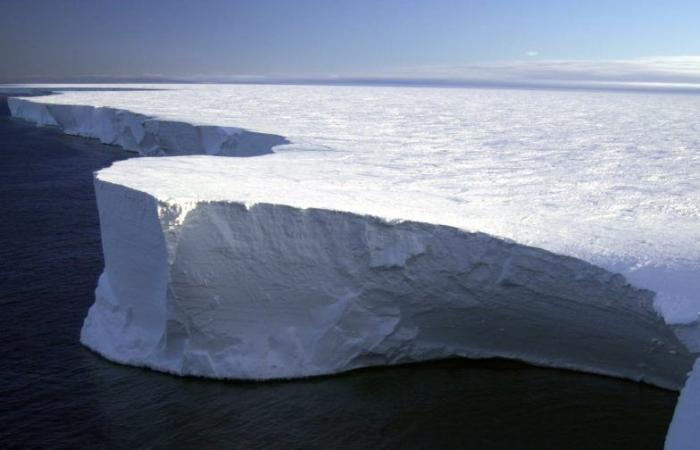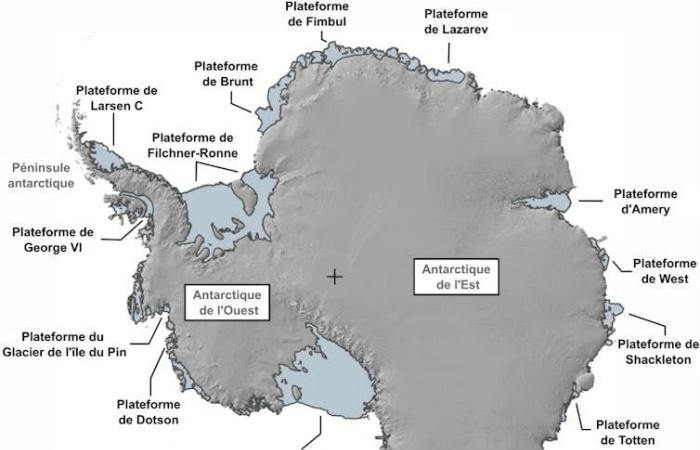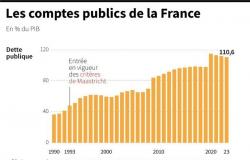On our planispheres centered on inhabited latitudes, we do not notice the extent to which Antarctica and the southern seas are central… for ocean circulation, and therefore for the adaptation of the Earth system to climate change. And yet, they could be the site of irreversible changes, the famous climatic “tipping points”.
As our greenhouse gas emissions build up in the atmosphere and cause our planet’s average temperatures to rise, polar ice is melting and flowing into the oceans at a rapid rate. This has the effect of accelerating the rise in water levels: while it was 1.3 millimeters per year between 1901 and 1971, it was measured at 3.7 millimeters per year between 2006 and 2018. However, the Water level projections could be underestimated due to physical phenomena amplifying ice melt.
Antarctica is a continent covered in immense glaciers which slide towards the sea under the influence of their own weight. When they reach the sea, they continue their flow and then float on the surface of the water: these are called ice shelves. Large areas of water (up to the size of France) are covered by these thick layers of ice, forming subglacial seas. However, the latter are suspected of being able to heat up suddenly, weakening the platforms which limit the flow of glaciers.
The impact of the melting of these platforms on the rise in water levels would of course be significant, because it would destabilize the glacier upstream on the rock, but it must also be emphasized that the massive release of meltwater into the he Southern Ocean could disrupt the global circulation of the ocean, and have effects that reverberate as far as the northern Atlantic Ocean.
Adapted and translated from Wikipedia, Provided by the author
Indeed, due to its central position, the Southern Ocean is a key part of the climate system. It is made up of a set of continental seas adjoining the coasts of Antarctica, as well as the Antarctic circumpolar current, forced by powerful westerly winds between the 60e et 80e parallels of the southern hemisphere. This current controls the rise of deep warm waters from the Atlantic, Pacific and Indian tropical oceans towards Antarctica, bringing them to the continental seas where the ice melts.
Read more: Melting ice and climate, what is happening in Antarctica?
The sensitivity of melting ice to the temperature of subglacial seas
In Antarctica, the melting of ice shelves is mainly due to heat transmitted by subglacial seas. Also, the temperature of the water under the ice is decisive in estimating the melting speed. More precisely, it is the difference between the solidification temperature of seawater (around -2°C because it is salty) and the temperature of the subglacial sea that matters.
Thus, seawater that warms from -1°C to 0°C doubles the difference at the solidification point, which has considerable consequences for melting.
Two types of water masses can enter subglacial cavities. First, deep warm waters of tropical origin, whose temperatures are generally between -1°C and 2°C. Secondly, cold surface waters, in contact with the frigid polar atmosphere, having temperatures varying from -2°C to -1°C. The infiltration of warm water into subglacial cavities would cause the ice shelves to thin and then disappear. The continental glaciers that they hold back, like the cork of a lying bottle holds back the wine, would then be free to flow quickly into the polar waters.
Adapté et traduit de The Sensitivity of the Antarctic Ice Sheet to a Changing Climate : Past, Present, and Future, Noble et coll., Reviews of Geophysics, 2020, Provided by the author
However, the intrusion of warm water into subglacial seas is not necessarily fatal. In West Antarctica, these dense waters manage to reach and melt the deep part of the ice shelves, forcing the glaciers to retreat. But in East Antarctica, this same attempt is often thwarted by the formation of ice floes due to the presence of cold winds on the surface. Indeed, when sea water freezes, only the water turns into ice, leaving high quantities of salt on the surface. Thus, these cold surface waters become increasingly dense and sink to the ocean floor, replacing warm water masses and greatly reducing melting under the ice shelves.
Global warming could cause an irreversible shift by preventing cold surface waters from flowing
Recently, scientific studies have suggested that climate change could favor the shift from cold cavities to warm conditions. Indeed, a change in winds or an increase in atmospheric temperature could reduce the formation of ice floes and therefore dense water capable of sinking.
Such a transition would already be potentially at work at the Dotson platform, where the observation of variations in ocean temperatures and salinity could be the signature of a regime change. In East Antarctica, numerical simulations show that the Filchner-Ronne cavity could fill with water at -1°C rather than at -2°C as is currently the case. A transition to warm conditions would accelerate the disappearance of this platform which retains 10% of the volume of ice in Antarctica, likely to increase sea level by more than 5 meters.

Adapted and translated from the Scott Polar Research Institute at the University of Cambridge
One of the fears associated with this type of transition is the non-reversibility of the process. Indeed, when hot water flows penetrate the cavity, the increased melting of the platform causes the formation of less dense fresh water which will end up on the surface, which will not flow to replace the hot water at depth. . We find ourselves facing what we call a climatic tipping point: from a certain threshold of climate modification, these glacial cavities can suddenly fill with warm water, irreversibly.
Turbulence dictates the mixing of hot and cold waters but remains poorly understood
At present, these regime changes remain uncertain. Indeed, global climate models poorly describe the physics of mixing meltwater with seawater. This mixing occurs through the disordered and chaotic movement of water on a small scale, called turbulence. However, it is this mixture which is at the origin of this waltz between surface waters and deep waters. In particular, it is the turbulence which dictates the basal melting of the platform, which supplies low-salinity and cold water to the surface waters, then the intensity of the diving of these surface waters, loaded with salt, by gravity.
Predicting the rate of basal melting of ice shelves requires knowing whether the cold meltwater remains in contact with the ice to form an insulating layer or if, on the contrary, it is evacuated as it melts. melts and gives way to warmer ocean water. And it depends on many parameters: salinity, temperature, ocean turbulence and the geometry of the platform.
Consider the example of a flat ice shelf, floating on a mass of warm salty water at rest. The hot water transfers its heat to the ice by diffusion, which begins to melt. Since the meltwater is softer, it is less dense and remains sandwiched between the roof formed by the platform and the salty ocean. Here it effectively fulfills its role of inhibiting melting. But if we add a sufficiently powerful sea current, then the mixing of the two water masses is activated by turbulence and this protective layer disappears. Likewise, if the ice shelf is no longer flat but inclined, then the melting water will begin to rise along the slope due to its lightness and again directly expose the ice to the heat of the ice. ‘ocean.

NOAA
Dense (salt) water diving is similarly difficult to predict because turbulence can work both ways. On the one hand, vertical mixing can drag the surface cold water layer downward. On the other hand, lateral mixing – always by turbulence – of surface waters with less dense waters offshore could lighten them and prevent their deep dive.
Three approaches to understanding melting below ice shelves
Some studies focus on collecting field data, carrying out mass balances using satellite observations or going on site to probe salinity, temperature and current speed under ice shelves. These expeditions are expensive and provide access to scattered information but are essential for understanding the reality on the ground in Antarctica.
At the ENS Lyon Physics Laboratory, we attempt to reproduce and complete these observations by carrying out high-resolution numerical simulations, then providing a prediction of the behavior of the platforms and associated flows. However, some phenomena are still too numerically expensive to resolve. This is why we also develop physical experiments, in the controlled environment of the laboratory to isolate and study these phenomena.

This article is published as part of the Science Festival (which takes place from October 4 to 14, 2024), and of which The Conversation France is a partner. This new edition focuses on the theme “ocean of knowledge”. Find all the events in your region on the Fetedelascience.fr website.










